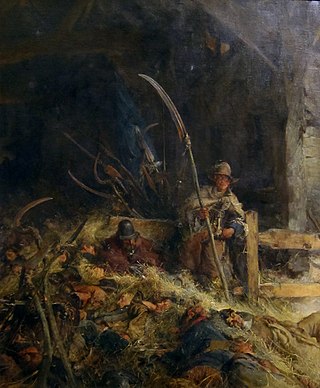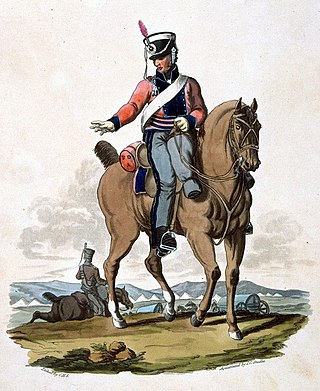Related Research Articles

The King's Body Guard of the Yeomen of the Guard is a bodyguard of the British monarch. The oldest British military corps still in existence, it was created by King Henry VII in 1485 after the Battle of Bosworth Field.

The Battle of Sedgemoor was the last and decisive engagement between the Kingdom of England and rebels led by the Duke of Monmouth during the Monmouth rebellion, fought on 6 July 1685, and took place at Westonzoyland near Bridgwater in Somerset, England, resulting in a victory for the English army.

The National Guard is a French military, gendarmerie, and police reserve force, active in its current form since 2016 but originally founded in 1789 during the French Revolution.

The Royal Military Police (RMP) is the corps of the British Army responsible for the policing of army service personnel, and for providing a military police presence both in the UK and while service personnel are deployed overseas on operations and exercises. Members of the RMP are often known as 'Redcaps' because of the scarlet covers on their peaked caps and scarlet coloured berets.

Mounted police are police who patrol on horseback or camelback. Their day-to-day function is typically picturesque or ceremonial, but they are also employed in crowd control because of their mobile mass and height advantage and increasingly in the UK for crime prevention and high visibility policing roles. The added height and visibility that the horses give their riders allows officers to observe a wider area, and it also allows people in the wider area to see the officers, which helps deter crime and helps people find officers when they need them. When employed for crowd control, there is a risk that some people may be trampled. Due to this, authoritarian regimes often use mounted police to suppress protests, as the public generally does not view these "accidental" deaths as resulting from a deliberate use of deadly force. In at least one case this has resulted in the police officer riding the horse to be sued.

Amalienborg is the official residence for the Danish royal family, and is located in Copenhagen, Denmark. The Danish Head of State, Queen Margrethe ll, resides in the palace during autumn and winter. It consists of four identical classical palace façades with rococo interiors around an octagonal courtyard ; in the centre of the square is a monumental equestrian statue of Amalienborg's founder, King Frederick V.

Quartermaster is a military term, the meaning of which depends on the country and service. In land armies, a quartermaster is generally a relatively senior soldier who supervises stores or barracks and distributes supplies and provisions. In many navies, a quartermaster is an officer with particular responsibility for steering and signals. The seaman is a non-commissioned officer rank; in some others, it is not a rank but a role related to navigation.

The City of Glasgow Police or Glasgow City Police was the police covering the city and royal burgh of Glasgow, from 1800 to 1893, and the county of city of Glasgow, from 1893 to 1975. In the 17th century, Scottish cities used to hire watchmen to guard the streets at night, augmenting a force of unpaid citizen constables. On 30 June 1800 the authorities of Glasgow successfully petitioned the British Government to pass the Glasgow Police Act establishing the City of Glasgow Police. It served Glasgow from 1800 to 1975, when it was amalgamated into Strathclyde Police.

The Halifax Regional Police (HRP) is one of a number of law enforcement agencies operating in the Halifax, Nova Scotia; the other primaries being the Royal Canadian Mounted Police and the Canadian Forces Military Police. The city also is home to a small detachment of the Canadian National Railway Police.
Bermuda Militia, under Militia Acts 1687–1813. Although the Bermuda Parliament had been formed in 1620, prior to 1687, the Bermudian Militia was raised and organised without reference to a Militia Act. The Crown took over the administration of the Colony from The Somers Isles Company in 1684.

Gabriel Nicolas de la Reynie is considered to be the founder of the first modern police force.

The history of organized firefighting began in ancient Rome while under the rule of the first Roman Emperor Augustus. Prior to that, Ctesibius, a Greek citizen of Alexandria, developed the first fire pump in the third century BC, which was later improved upon in a design by Hero of Alexandria in the first century BC.

The Affair of Néry was a skirmish fought on 1 September 1914 between the British Army and the German Army, part of the Great Retreat from Mons during the early stages of the First World War. A British cavalry brigade preparing to leave their overnight bivouac were attacked by a German cavalry division of about twice their strength, shortly after dawn. Both sides fought dismounted; the British artillery was mostly put out of action in the first few minutes but a gun of L Battery, Royal Horse Artillery kept up a steady fire for two and a half hours, against a full battery of German artillery. British reinforcements arrived at around 8:00 a.m., counter-attacked the Germans and forced them to retreat; the German division was routed and did not return to combat for several days. Three men of L Battery were awarded the Victoria Cross for their part in the battle, the battery was later awarded the honour title of "Néry", the only British Army unit to have this as a battle honour.

The Scots Army was the army of the Kingdom of Scotland between the Restoration in 1660 and the Acts of Union of 1707. A small standing army was established at the Restoration, which was mainly engaged in opposing Covenanter rebellions and guerrilla warfare pursued by the Cameronians in the East. There were also attempts to found a larger militia. By the Glorious Revolution in 1688–89 the standing army was over 3,500 men. Several new regiments were raised to defend the new regime and, although some were soon disbanded several took part in William II's continental wars. By the time of the Act of Union in 1707, the army had seven units of infantry, two of horse and one troop of Horse Guards. Early units wore grey, but adopted red like the English army after 1684. New Scottish and particularly Highland regiments would be raised from the 1740s, some of which had a long history within the army.

The Guards Memorial, also known as the Guards Division War Memorial, is an outdoor war memorial located on the west side of Horse Guards Road, opposite Horse Guards Parade in London, United Kingdom. It commemorates the war dead from the Guards Division and related units during the First World War, and of the Household Division in the Second World War and other conflicts since 1918.

In the 10th century Paris was a provincial cathedral city of little political or economic significance, but under the kings of the Capetian dynasty who ruled France between 987 and 1328, it developed into an important commercial and religious center and the seat of the royal administration of the country. The Île de la Cité became the site of the royal palace and the new cathedral of Notre-Dame, begun in 1163. The Left Bank was occupied by important monasteries, including the Abbey of Saint-Germain-des-Prés and the Abbey of St Genevieve. In the late 1100s, the collection of colleges on the left bank became one of the leading universities in Europe. The Right Bank, where the ports, central markets, artisans and merchants were located, became the commercial center of the city, and the merchants assumed an important role in running the city. Paris became a center for the creation of illuminated manuscripts and the birthplace of Gothic architecture. Despite civil wars, the plague, and foreign occupation, Paris became the most populous city in the Western world during the Middle Ages.
The King's Birthday Honours 1943 were appointments by King George VI to various orders and honours to reward and highlight good works by people of the British Empire. They were published on 2 June 1943 for the United Kingdom and Canada.
The New Year Honours 1904, announced at the time as the Indian Honours, were appointments to various orders and honours of British India. The list was published in The Times on 1 January 1904, and the various honours were gazetted in The London Gazette on the same day.

The Cavalry Staff Corps was a unit formed during the Napoleonic Wars to keep discipline in the British Army. Consisting of four troops of cavalry, the corps was first raised in 1813 during the Peninsular War to deal with an excess of criminality and desertion in the Duke of Wellington's armies. It was disbanded after that campaign ended in 1814 but was reformed in 1815 during the Hundred Days campaign. The corps also served in the subsequent occupation of France. The unit was Britain's first standing military police force. A successor unit was raised for service in the Crimean War of 1853–1856 and a permanent military police was established in 1877.
The Maréchaussée were corps of soldiers in the armies of France initially put in charge of military policing and justice in the Middle Ages, and later extended to civilian responsibilities. They gradually coalesced into a police force with jurisdiction over the entire population on almost the entire territory of France. They retained powers of extraordinary justice until the French Revolution.
References
- ↑ François Husson (1903), MARCHAL & BILLARD (ed.), Artisans français : étude historique - Les charpentiers (in French), Paris
{{citation}}: CS1 maint: location missing publisher (link)